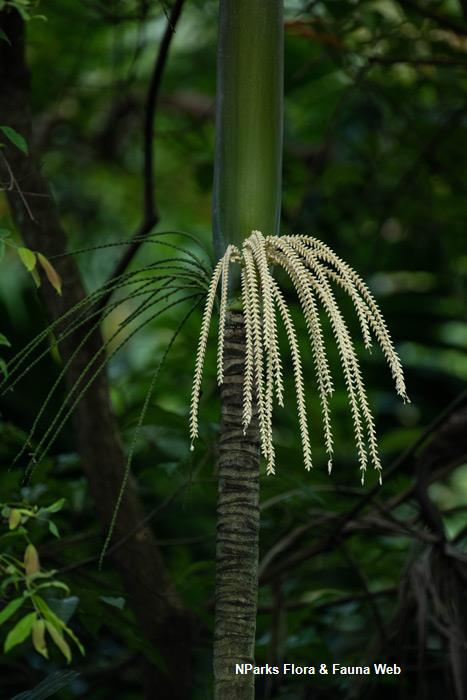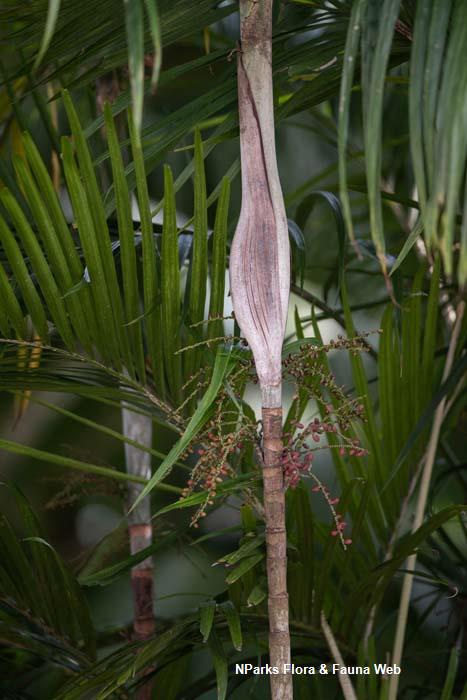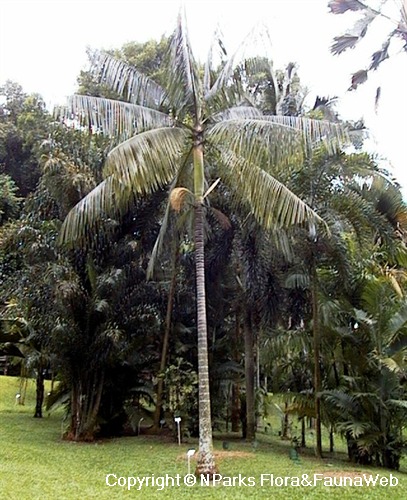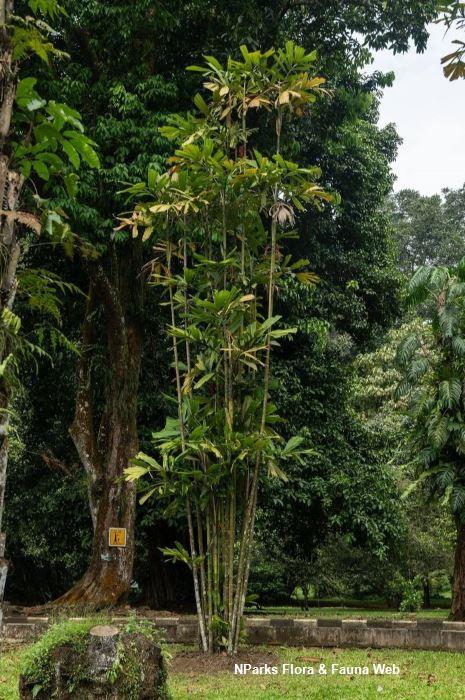_lowres.jpg)
Back
Hydriastele beguinii (Burret) W.J.Baker & Loo
| Family Name: | Arecaceae (Palmae) |
| Synonyms: | Siphokentia beguinii Burret, Siphokentia pachypus Burret |
Hydriastele beguinii is a palm that is endemic to Maluku. Growing up to 10 m tall, it has a solitary growth habit and the stems are conspicuously ringed with leaf scars.
Name
Classifications and Characteristics
| Plant Division | Angiosperms (Flowering Seed Plants) |
|---|---|
| Plant Growth Form | Palm |
| Lifespan (in Singapore) | Perennial |
| Mode of Nutrition | Autotrophic |
| Maximum Height | 10 m |
Biogeography
| Native Distribution | Maluku |
|---|---|
| Native Habitat | Terrestrial |
| Preferred Climate Zone | Tropical |
| Local Conservation Status | Non-native |
Description and Ethnobotany
| Growth Form | It is a palm with solitary growth habit. It can grow to 10 m tall and have a cylindrical crownshaft. |
|---|---|
| Foliage | The leaves are compound, arching and feather-shaped (pinnate). They are irregularly divided into narrow and broad leaflets with the prominent terminal part undivided. |
| Stems | The stems are upright and are conspicuously ringed with leaf scars. |
| Flowers | The inflorescence occurs below the crownshaft. It is horsetail-like and comprises of many tiny cream-coloured flowers. |
| Fruit | The fruits are cylindrical to ellipsoid and turn red when ripe. Each fruit contains one seed within. |
| Habitat | It is found in rainforest. |
| Associated Fauna | Flowers are pollinated by insects. |
| Etymology | Greek Hydriastele means water column, which refers to the stems of some species growing near water. The specific epithet commemorates Victor M.A. Béguin (1886 – 1943), a Dutch Botanist who was a prominent plant collector in Malesian, Maluku and Indonesia New Guinea region. |
Landscaping Features
| Desirable Plant Features | Ornamental Foliage |
|---|---|
| Landscape Uses | Parks & Gardens |
Fauna, Pollination and Dispersal
| Pollination Method(s) | Biotic (Fauna) |
|---|
Plant Care and Propagation
| Light Preference | Full Sun, Semi-Shade |
|---|---|
| Water Preference | Moderate Water, [Remarks] (Do not let the soil dry out between each watering.) |
| Plant Growth Rate | Moderate |
| Rootzone Tolerance | Moist Soils |
| Propagation Method | Seed |
Foliar
| Mature Foliage Colour(s) | Green |
|---|---|
| Prominent Young Flush Colour(s) | Green |
| Foliar Type | Compound |
| Foliar Shape(s) | Palm Fronds (Pinnate / Feather) |
Non - Foliar and Storage
| Trunk Type (Palm) | Solitary Habit, Aboveground |
|---|
Fruit, Seed and Spore
| Mature Fruit Colour(s) | Red |
|---|
References
| References | Dransfield J, Uhl NW, Asmussen CB, Baker WJ, Harley MM, Lewis CE. (2008). Genera Palmarum. Richmond, UK: Royal Botanic Gardens, Kew. |
|---|
Image Repository
Others
| Master ID | 30425 |
|---|---|
| Species ID | 4734 |
| Flora Disclaimer | The information in this website has been compiled from reliable sources, such as reference works on medicinal plants. It is not a substitute for medical advice or treatment and NParks does not purport to provide any medical advice. Readers should always consult his/her physician before using or consuming a plant for medicinal purposes. |

_lowres.jpg)




